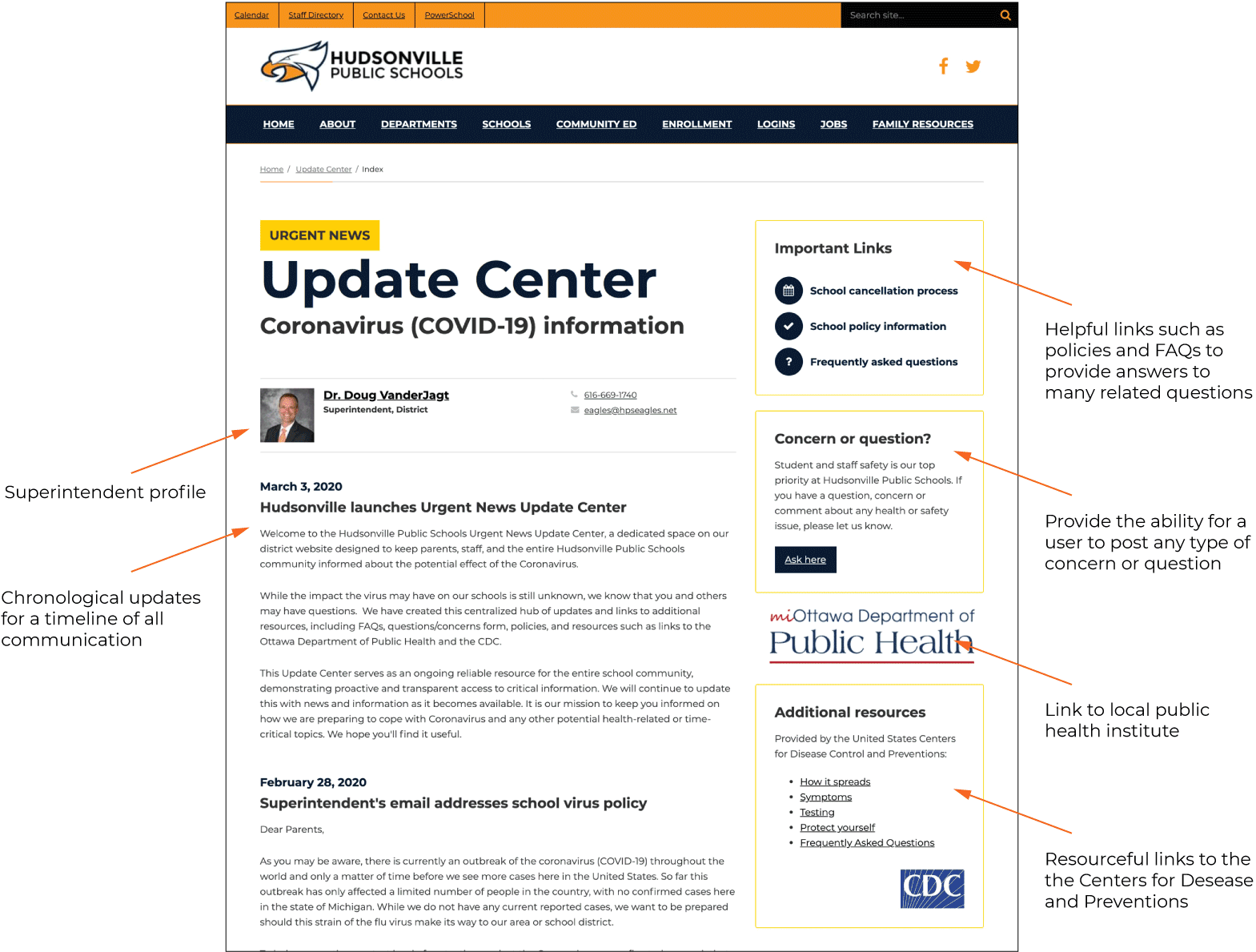It’s spreading. Not just the virus, but the public buzz around what to do about it. The Coronavirus COVID-19 has breached our borders and is showing up in a school district near you. So as the medical researchers scramble to develop protocols and a vaccine, are you scrambling to communicate with your school community?
No need to panic. In fact, that is the last trait you want to depict for your school. But there is a need to react by developing your own plan of attack on battling the Coronavirus in your school communications.
Time to panic or plan?
Nations around the world are bracing for outbreaks of the Coronavirus COVID-19, as, at last count, some some 50 countries have recorded cases of the virus with little or no clue how it's being transmitted.
Italy is closing all schools. Japan is taking major preemptive steps. In an effort to limit the spread of the virus, Japanese prime minister Shinzo Abe has closed all schools up to and through that country’s spring holidays. Spain, Great Britain: the list grows. The New York Times reports that in a preventative measure in the Middle East, the Iranian government has canceled sacred Friday Prayers, a communal ritual that’s a staple in the Islamic faith.
“It’s not a matter of if the Coronavirus affects your school. It’s a matter of when.”
And of course, here in the states, the Trump administration is balancing tenuous messaging by downplaying the scare for economic reasons, while simultaneously ramping up public health contingencies should the virus start showing up in greater numbers.
Meanwhile, SchoolNow has been working closely with its customers to help them put in place the mechanism to quickly and efficiently publish updates on their respective plans, policies and procedures via online communications. But it all, of course, starts with planning.
1. Create your plan
Someone said it: it’s not a matter of if the Cornonavirus is going to be here, it’s a matter of when. At last count, 12 states in the U.S. have reported cases. Likewise, it's not a matter of if you’re going to start communicating to your school stakeholders about your policies and procedures, it’s a matter of when. And frankly, the sooner the better to help avoid panic on everyone’s part.
Getting out in front of potentially disruptive news and events goes a long way in stemming the potential flood of inquiries and conjecture that may arise from the public. As the Coronavirus triggers cancellations, closures and contingency planning across the country, what are your plans?
Get more info here about SchoolNow's Coronavirus COVID-19 Urgent News Update Center.
“We got our first phone call (about the virus) to our superintendent, and we used that as a spark to put together a communications plan,” said Rebecca Fabiano, community education director for Hudsonville (Michigan) Public Schools. The day after the call, Fabiano huddled with her superintendent Dr. Doug VanderJagt and, anticipating more calls, talked about formulating a plan and timing.
“We started early with an email sent to all parents and staff that basically addressed what we know to date and then some preventative measures students, parents, and staff should be taking to protect themselves. Pretty general stuff, but a good touch point and a good start,” she said.
Fabiano and other Hudsonville staff mapped out other plan elements, including developing possible FAQs and links to those with health-related knowledge to speak authoritatively on the Coronavirus subject.
2. Don’t go it alone
Throughout this and any other crisis or time-sensitive communications, it’s best not to work in isolation. Especially when it comes to health and safety issues affecting your school community, be sure to surround yourself with the people and resources that can help you communicate in an organized and professional manner.
Just days after that first phone call from a concerned parent, Fabiano turned to her website provider, SchoolNow, for help in mapping out Hudsonville's communication strategy. The SchoolNow team of content, design, and production people suggested a dedicated page or department on the Hudsonville site where parents could go to get updates on how the school is preparing and dealing with a possible case.
The SchoolNow team worked around the clock to develop the Update Center, and launched it in 48 hours. Since then, SchoolNow has deployed Update Centers for hundreds of schools.
In just two days, Hudsonville had the prototype Coronavirus Update Center up and running on its website, serving as an accessible resource for the entire community. In less than a week, similar solutions are being executed for other SchoolNow customers.
Additional outside help starts with your local county and state health departments. These official organizations are the ones responsible for disseminating the critical information and updates. Then, at the school district level, you are largely charged with relaying that info rapidly to your entire school community.
Of course, most city, county and state health authorities are taking their cues from the U.S. Centers for Disease Control and Prevention. It’s at this national level where most of the media alerts and directives are coming from. Your superintendent or district spokesperson would do well to cite and defer to these local and national authorities when making statements.
Another source of support during these times is to enlist the help of PR consultants who specialize in school crisis communications. They can be hired on retainer or project basis and are typically equipped to move quickly on issues like possible school disruption.
3. Create a communication hub
To make it easy on everyone involved – school leadership, staff, parents, students, the entire school community – and you, creating an online communication hub on your district website is the best method for controlling the time-sensitive content you need to make available.
In her planning at Hudsonville, Fabiano took stock of existing policies and procedures, including the district’s Emergency Operations Plans (E.O.P) and school cancellation policy, then met with her website provider SchoolNow, to develop ideas for an innovative dedicated Coronavirus Update Center for the Hudsonville district website.

From there, she and her SchoolNow team developed a page and helpful links on the district website that would include FAQs and links to outside resources in addition to the other policies and procedure documentation. The Update Center also includes a built-in form for parents – or others in the community – for submitting questions or concerns.
An added benefit of the Update Center is that it provides an easy way to get the entire district staff on the same page when it comes to articulating the district preparedness and response to virus news. “We want to reach out thoroughly to our parents especially,” said Fabiano, “but the info there helps keep our teachers and administrators up to speed too with what’s going on.”
What are you waiting for?
If we’re learning anything these days about how fast and widespread news can travel, the Coronavirus outbreak is a prime example how important it is to (try to, at least) control information as much as possible.
Spread of information itself may be responsible in part for the fear that’s brewing and having major impact on tourism, public congregation, the global economy, and now, your school. As news channels and social media continue to splatter headlines, the degree of alarm grows – perhaps at an exaggerated rate, perhaps not.
Be prepared. Get a plan, get some help, and create a centralized communication hub for the commotion that is building around the Coronavirus – and that next crisis, for that matter – to best serve your entire school community.
Topics: Communication
About the author
Marketing director and content strategist for SchoolNow, Jay’s a former school public relations specialist who’s helped businesses, schools and colleges use the power of communications to improve their image, generate support, and optimize relationships. Reach him at jay@schoolnow.com.
.png?width=64&height=63&name=Group%20(4).png)
.png?width=66&height=64&name=Group%20(5).png)
.png?width=56&height=60&name=Group%20(6).png)
.png?width=66&height=52&name=Group%20(7).png)
.png?width=56&height=56&name=Group%20(9).png)
.png?width=59&height=52&name=Group%20(10).png)

